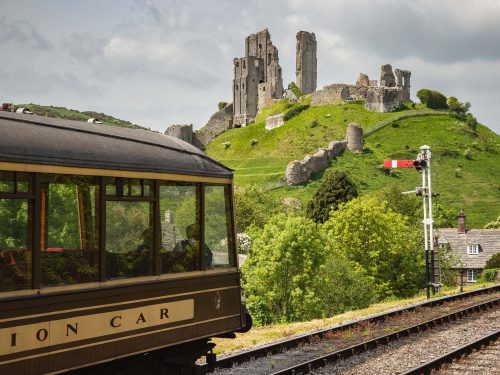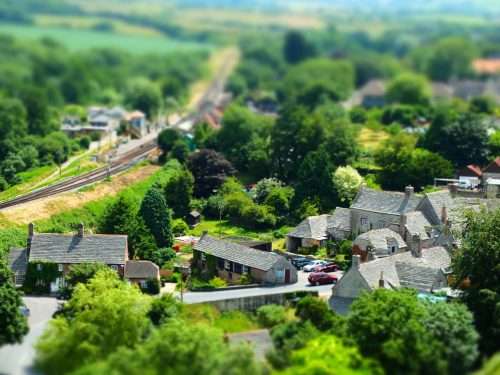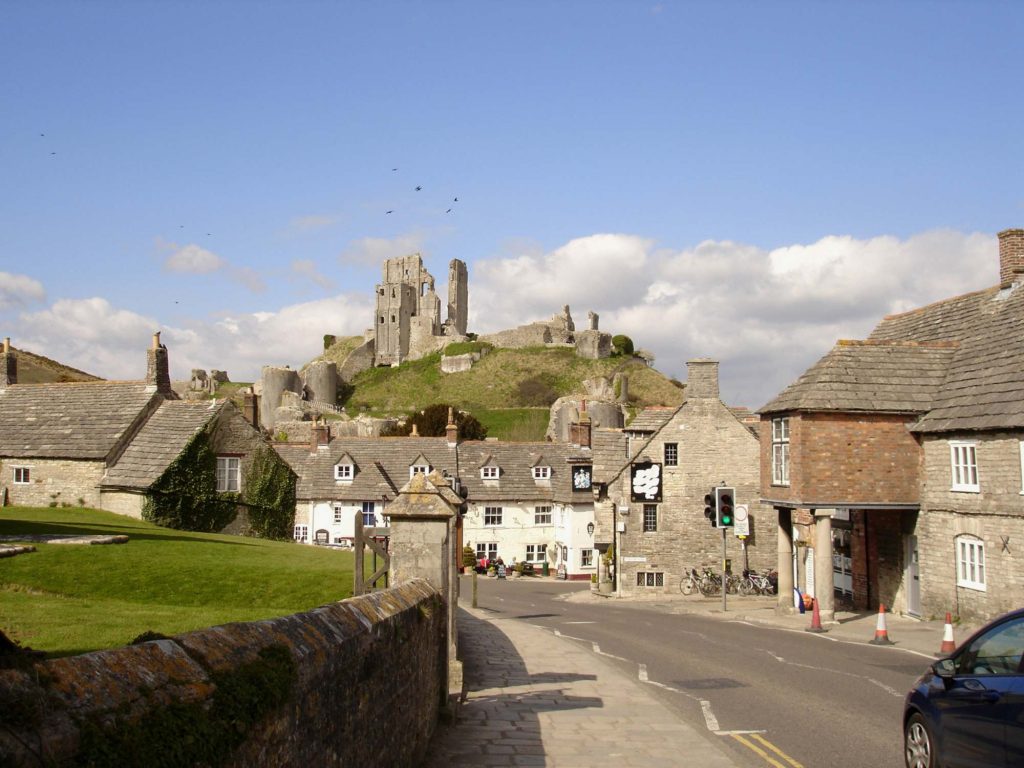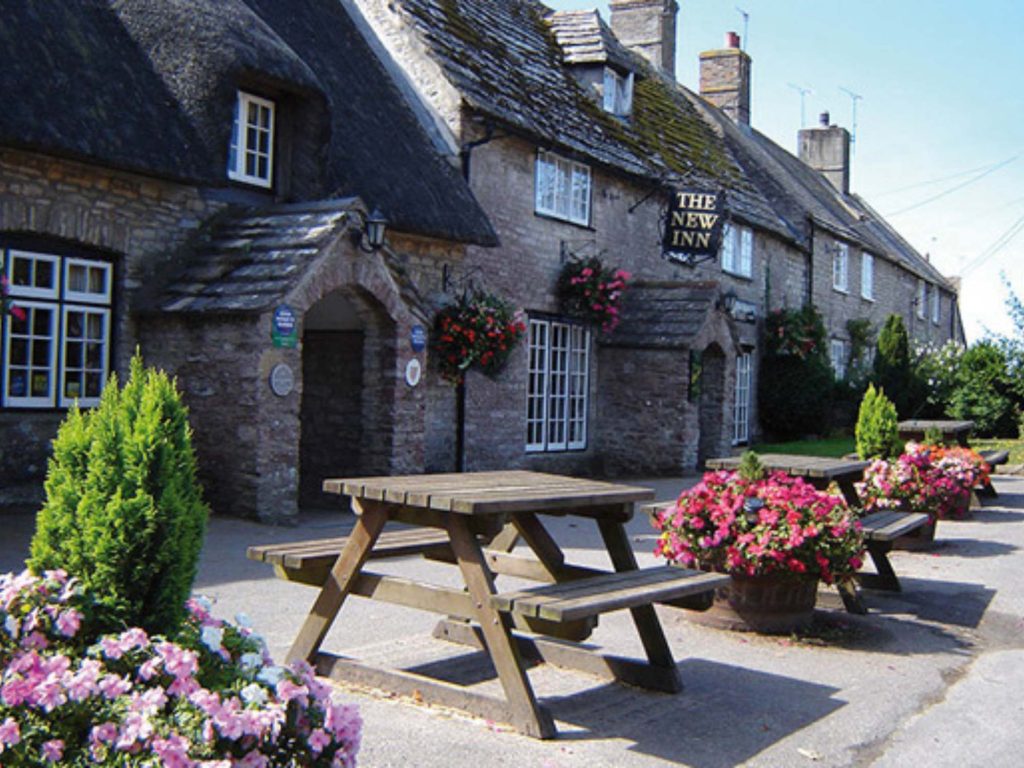

Corfe Castle, now a quintessential English village, can lay claim to a dramatic past. Site of a royal murder and a civil war siege, which leaves us with the National Trust owned ruins we see today. The ruins overlook a beautiful village, consisting of chocolate box Purbeck stone cottages. Surrounded by breath-taking countryside bordered by the Purbeck Hills, it is an exceptional place for views, walking, biking, photography and wildlife.
In AD 1090 following William’s conquest of Britain, the Corfe Norman Castle was begun. William’s son Henry I was crowned in 1100 and developed the castle keep and inner bailey. Henry left no legitimate male heir; his daughter Matilda claimed the throne, reinforced by an alliance with the House of Anjou through her husband Geoffrey Plantagenet. King Steven claimed the throne for the House of Blois and Civil War ensued. Corfe was besieged by Stephen, but Baldwin de Redvers held the castle for the Empress.
For the whole of the Medieval period, Corfe was a Royal Castle. Kings used it as one of the five royal castles. King John kept his crown jewels here. Edward II was imprisoned here. Much torturing and murder took place. Henry VII gave it to his mother but later it reverted to Henry VIII. Queen Elizabeth sold it to her Chancellor, Christopher Hatton, who fortified it further in readiness for the Spanish Armada.
The Hatton Family sold the castle to the Bankes family. Sir John Bankes was Lord Chief Justice to King Charles I. Civil war broke out and it was left to Lady Bankes (Brave Dame Mary) to defend the castle in 1643 and 1645 through two sieges. She was finally overcome by the treachery of one of her own officers, Colonel Pitman. Following an Act of Parliament, the Castle was then blown up from the inside by engineers.
Corfe Castle is perhaps most famous as the setting of a royal murder. Elfrida invited the then king Edward to visit Corfe Castle when he was hunting nearby. As he approached the castle, she greeted him with a cup of mead and when he bent down to take it, her attendant stabbed him, his horse then bolted and King Edward became Edward the Martyr. Her son Ethelred became King but due to his age he was always known as Ethelred the Unready. Most modern visitors can overlook the castle bloody past, the ruins have recently polled as one of the most romantic ruins in England.

You can go back in time and enjoy a ride on the restored Swanage railway. Wait for the train on the restored Corfe Castle station, alight and travel through the Purbeck countryside with stops at Herston, Harmans Cross and onto the seaside town of Swanage.
The railway puts on a number of exciting events including Meet Thomas the Tank Engine, Santa Specials and travel on the Flying Scotsman. The Swanage Railway offers a more intensive heritage steam and diesel timetable train service than virtually any other preserved railway.
Steam and diesel galas, Family events plus regular Evening Dining and Sunday Lunch services complement themed events such as the highly popular Santa Special trains during the run up to Christmas.
The award-winning standard gauge preserved steam railway is located in Dorset with easy access from neighbouring Hampshire and the South of England. Visitors can experience a unique journey through six miles of beautiful scenery passing the magnificent ruins of Corfe Castle.

Opened in 1966 to the public, the Model Village depicts the Castle and village as it was in 1646. You can compare the real castle with the Model castle from our garden, this gives a fantastic idea of how it used to look when it was home to Lady Banks.

Evidence of a civilization dating back to 6000 BC exists on Corfe Common, on the southern edge of the village. Several barrows (burial mounds) dot the common, visible after leaving West Street. These people likely migrated from Europe across the “land bridge” that once included the Purbeck Hills.
Substantial evidence of Celtic and Roman settlements abounds, including a hoard of coins found on Corfe Common. A legend, later chronicled by Thomas Hardy, tells of an entire Roman legion vanishing in Purbeck, leaving only its ghost. However, a massive battle between Celts and Romans at Maiden Castle led to the Celts’ destruction.
The village of Corfe Castle primarily stretches along East and West Streets. Generally, the further you move from the castle, the newer the cottages become, with a few exceptions. Many believe that the stone cottages were built using leftover stone from the castle’s demolition. Corfe Castle is one of England’s prettiest villages, with its Purbeck stone cottages and many thatched roofs.
Corfe Castle is a haven for nature lovers and walkers. A vast network of paths radiates from the village, allowing you to choose between a vigorous hike up the Purbeck Hills for spectacular views of the Corfe Valley, Brownsea Island, and Poole Harbour, or a more leisurely stroll to Church Knowle or across Corfe Common.
The village square offers a delightful selection of shops, pubs, and tea rooms. The Greyhound Pub, with the castle as a backdrop, is arguably England’s most photographed pub.

Church Knowle sits near Corfe Castle, easily accessible from there. Visitors can walk through farmland, crossing ancient stiles to reach the large village that the imposing castle ruins overlook. Alternatively, as the village lies at the foot of the Purbeck Hills, you can hike to the ghost village of Tyneham or to Creech, enjoying views of the Purbeck Peninsula and distant Brownsea Island.
The village, recorded in the Doomsday Book, boasts traditional Purbeck stone cottages lining the country road that passes through it. Church Knowle is home to both a delightful 17th-century pub (The New Inn, famous for its Blue Vinney Soup) and the Margaret Green Rescue Centre, which hosts various events yearly.
Church Knowle, a small village on the Isle of Purbeck in Dorset, England, hides historical treasures. Smedmore Hill shelters a well-preserved Iron Age or Romano-British settlement surrounded by fragmented “Celtic” fields. A mosaic pavement near East Creech hints at a Roman villa, and several sites reveal evidence of shale working.